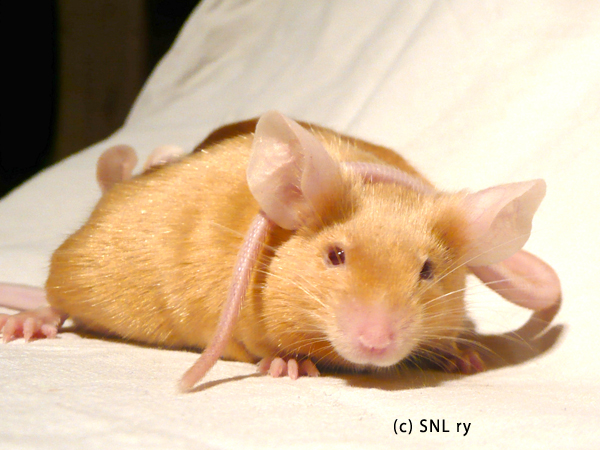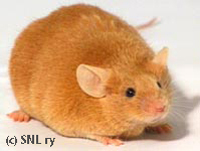Varieties
I - Self
Straw (str)
Ay/A \ Ay/a bc/* C/* d/d P/*, or
Ay/A \ Ay/a bc/* C/* d/d p/p
"The colour should bright mid-tone argente, but without silvering or underolour. Eyes black or pink."
Breeding information below the pictures.
Quick Look
Common problems include sootiness, mealiness brought in by blue dilution (in blue diluted mice pigment of single hairs is unevenly distributed, with tips tending to have less pigment than hair roots), darkening of colour with age, and all typical problems of dominant lethal red mice. Like all Ay mice, straw doesn't breed true.
History
Straw is the "oldest cream" of British fancy, the cream that was bred and shown before the 1930's.
Genetic Background
Genetically, straw is simply a diluted red or fawn with the chocolate dilution to help reducing sootiness and to clearing the colour up a bit. In other words, straw is "blue red / fawn" or "lilac red / fawn". Note, that bc/* (or b/b) isn't absolutely necessary.
In More Practical Terms...
Like all Ay varieties, straw is heterozygous and as mentioned already, it will not breed true - that is, straw x straw doesn't bring only straw, but other varieties as well. Which varieties pop up depends on the genetic background of the straws in question.
Straw, especially black eyed, combines the difficulties of both red and blue. With straw, one can witness the wondrous world of mouse variety faults and get a mouse which is both sooty and mealy at the same time (and fat and wrinkly eared to boot)! Leaving the worst case scenarios behind, the variety is quite pretty. With pink eyed straws, there's much less problem of fat, small ears and mealiness. On the other hand, problem of sooty colouring is replaced by "silver" - diluted traces of shading.
Unlike with red and fawn, one can breed straw in both recognized eye colours in same lines - if one so wishes. Still, it is easier to pick an eye colour and selectively breed towards the required shade in the chosen "version".
Faults and ruining genes you should not let into a strain of straws include umbrous, too dark pigmentation, mealiness and leaden.
Umbrous tends to be brought in by good black, blue and chocolate tans, good blacks, chocolates, dark blues and of course sables. Umbrous is something one simply does not want on a self Ay variety, as it causes shadings and sootiness.
Too dark pigmentation, especially too red, is unwelcome as straw is a rather delicate variety. It shouldn't resemble a "slightly too light red / fawn".
Leaden doesn't dilute red pigment as much as blue dilution does. This makes leaden a poor candidate for breeding straw with - the end result is too dark. See the lower pic.
Starting From Scratch?
In order to get straw, you will need a red or fawn for the red gene Ay and a self or tanned mouse of a colour with the diluting genes. These colors include blue, Silver and lilac, as well as lilac agouti.
Ideal cross would be with a lilac (a/a bc/* d/d). Red x lilac cross will bring you mice carrying the required dilute. Colors produced may include (depending on the genetic make up of the red, one with Ay/a bc/* instead of Ay/A B* / bc/* or Ay/a B/* is preferred) red, agouti, cinnamon, black or chocolate (and tans, if the red was tanned). From here, take a red mouse from this litter and mate it to a mouse of diluted colour. Again, the lilac is the best option. In this generation you should already have some straws. If lilacs are not available (they are rather rare themselves), you can use blue. Work like I have mentioned with the red x lilac example. However, you are not likely to get Ay/* bc/* d/d P/* straws. Nevertheless these straws are likely to be of the required shade.
The above explanation applies to the black eyed version of cream. In order to breed pink eyed creams, you will need to introduce the pink eye gene to the strain. Replace red with fawn and / or similarly other above mentioned varieties with their "pink eyed versions".


